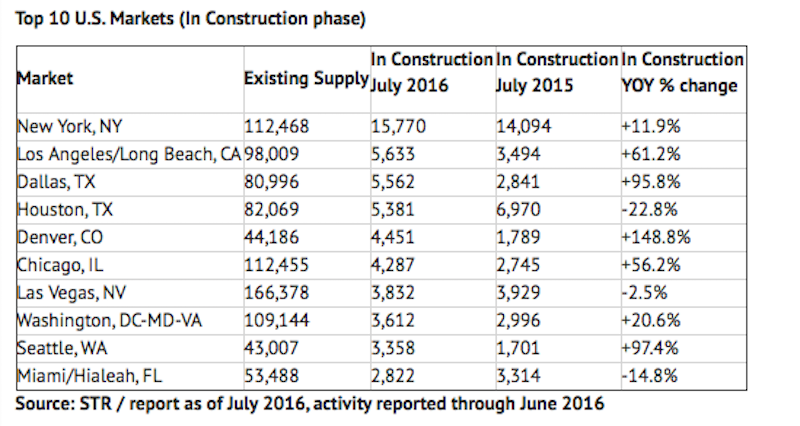The hotel sector is booming. But for how long?
Last April, the Real Deal, which tracks real estate news and trends, reported that new hotel construction in New York, which peaked in 2014, “is finally crashing” because so many new properties were coming online and developers were shying away from planning new projects.
In the first three months of this year, hoteliers had submitted permit applications for only six new hospitality properties, a total of 512 units, citywide. The Real Deal estimates that barely 10,000 new hotel rooms would be added to New York’s inventory this year, compared to more than 9,000 in 2014.
On Tuesday, Lodging Econometrics, the Portsmouth, N.H.-based market research firm, reported that New York City has the country’s largest hotel construction pipeline by project count: 196 projects and 32,121. New York has had the largest project count since the fourth quarter of 2011.
New York is followed by Houston (170 projects, 20,083 rooms), which has been the second-largest hotel market for the past 10 quarters, according to Lodging Econometrics. The rest of the top five hotel construction metros are Dallas (128 projects/15,662 rooms), Nashville (109/13,789), and Los Angeles (104/17,912).
A day before Lodging Econometrics released this data, STR, a global data benchmarking and analytics firm, released its July 2016 Pipeline Report, which showed 171,276 rooms in 1,305 projects under construction, a 32.6% increase over the same month a year ago.
STR estimates that New York, with an existing supply of 112,468 rooms, had 15,770 rooms under construction, 11.9% more than in July 2015. Three other markets—L.A./Long Beach, Dallas, and Houston—had more than 5,000 rooms under construction.
Conversely, Bobby Bowers, STR’s Senior Vice President of Operations, notes that the San Francisco/San Mateo, Calif., market may be reaching a saturation point, with room construction among the five-lowest in the country.

New York City continues to lead the nation in new hotel construction and rooms under contract. The nation's 26 largest cities are, for the most part, seeing strong growth in their hospitality sectors, even as some developers worry that too much inventory may be coming online. Chart: STR
Related Stories
Sustainability | Aug 15, 2023
Carbon management platform offers free carbon emissions assessment for NYC buildings
nZero, developer of a real-time carbon accounting and management platform, is offering free carbon emissions assessments for buildings in New York City. The offer is intended to help building owners prepare for the city’s upcoming Local Law 97 reporting requirements and compliance. This law will soon assess monetary fines for buildings with emissions that are in non-compliance.
Hotel Facilities | Aug 2, 2023
Top 5 markets for hotel construction
According to the United States Construction Pipeline Trend Report by Lodging Econometrics (LE) for Q2 2023, the five markets with the largest hotel construction pipelines are Dallas with a record-high 184 projects/21,501 rooms, Atlanta with 141 projects/17,993 rooms, Phoenix with 119 projects/16,107 rooms, Nashville with 116 projects/15,346 rooms, and Los Angeles with 112 projects/17,797 rooms.
Market Data | Aug 1, 2023
Nonresidential construction spending increases slightly in June
National nonresidential construction spending increased 0.1% in June, according to an Associated Builders and Contractors analysis of data published today by the U.S. Census Bureau. Spending is up 18% over the past 12 months. On a seasonally adjusted annualized basis, nonresidential spending totaled $1.07 trillion in June.
Hotel Facilities | Jul 27, 2023
U.S. hotel construction pipeline remains steady with 5,572 projects in the works
The hotel construction pipeline grew incrementally in Q2 2023 as developers and franchise companies push through short-term challenges while envisioning long-term prospects, according to Lodging Econometrics.
Adaptive Reuse | Jul 27, 2023
Number of U.S. adaptive reuse projects jumps to 122,000 from 77,000
The number of adaptive reuse projects in the pipeline grew to a record 122,000 in 2023 from 77,000 registered last year, according to RentCafe’s annual Adaptive Reuse Report. Of the 122,000 apartments currently undergoing conversion, 45,000 are the result of office repurposing, representing 37% of the total, followed by hotels (23% of future projects).
Hotel Facilities | Jul 26, 2023
Hospitality building construction costs for 2023
Data from Gordian breaks down the average cost per square foot for 15-story hotels, restaurants, fast food restaurants, and movie theaters across 10 U.S. cities: Boston, Chicago, Las Vegas, Los Angeles, Miami, New Orleans, New York, Phoenix, Seattle, and Washington, D.C.
Market Data | Jul 24, 2023
Leading economists call for 2% increase in building construction spending in 2024
Following a 19.7% surge in spending for commercial, institutional, and industrial buildings in 2023, leading construction industry economists expect spending growth to come back to earth in 2024, according to the July 2023 AIA Consensus Construction Forecast Panel.
Hotel Facilities | Jul 21, 2023
In Phoenix, a former motel transforms into a boutique hotel with a midcentury vibe
The Egyptian Motor Hotel’s 48 guest rooms come with midcentury furnishings ranging from egg chairs to Bluetooth speakers that look like Marshall amplifiers.
Sponsored | Fire and Life Safety | Jul 12, 2023
Fire safety considerations for cantilevered buildings [AIA course]
Bold cantilevered designs are prevalent today, as developers and architects strive to maximize space, views, and natural light in buildings. Cantilevered structures, however, present a host of challenges for building teams, according to José R. Rivera, PE, Associate Principal and Director of Plumbing and Fire Protection with Lilker.
Standards | Jun 26, 2023
New Wi-Fi standard boosts indoor navigation, tracking accuracy in buildings
The recently released Wi-Fi standard, IEEE 802.11az enables more refined and accurate indoor location capabilities. As technology manufacturers incorporate the new standard in various devices, it will enable buildings, including malls, arenas, and stadiums, to provide new wayfinding and tracking features.

















